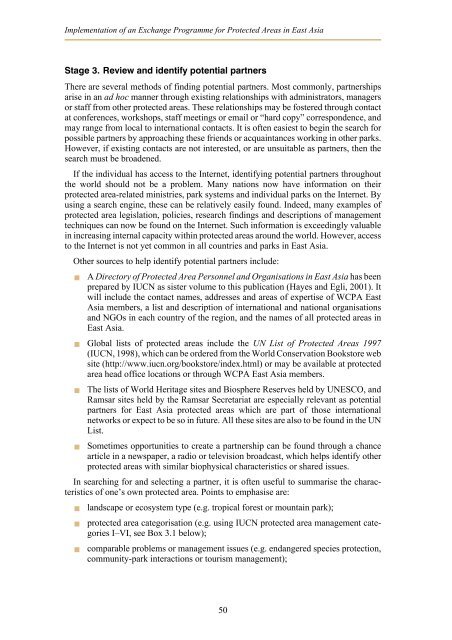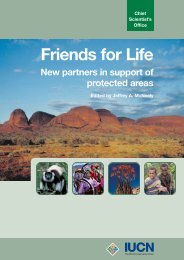Exchange programmes - IUCN
Exchange programmes - IUCN
Exchange programmes - IUCN
Create successful ePaper yourself
Turn your PDF publications into a flip-book with our unique Google optimized e-Paper software.
Implementation of an <strong>Exchange</strong> Programme for Protected Areas in East Asia<br />
Stage 3. Review and identify potential partners<br />
There are several methods of finding potential partners. Most commonly, partnerships<br />
arise in an ad hoc manner through existing relationships with administrators, managers<br />
or staff from other protected areas. These relationships may be fostered through contact<br />
at conferences, workshops, staff meetings or email or “hard copy” correspondence, and<br />
may range from local to international contacts. It is often easiest to begin the search for<br />
possible partners by approaching these friends or acquaintances working in other parks.<br />
However, if existing contacts are not interested, or are unsuitable as partners, then the<br />
search must be broadened.<br />
If the individual has access to the Internet, identifying potential partners throughout<br />
the world should not be a problem. Many nations now have information on their<br />
protected area-related ministries, park systems and individual parks on the Internet. By<br />
using a search engine, these can be relatively easily found. Indeed, many examples of<br />
protected area legislation, policies, research findings and descriptions of management<br />
techniques can now be found on the Internet. Such information is exceedingly valuable<br />
in increasing internal capacity within protected areas around the world. However, access<br />
to the Internet is not yet common in all countries and parks in East Asia.<br />
Other sources to help identify potential partners include:<br />
� A Directory of Protected Area Personnel and Organisations in East Asia has been<br />
prepared by <strong>IUCN</strong> as sister volume to this publication (Hayes and Egli, 2001). It<br />
will include the contact names, addresses and areas of expertise of WCPA East<br />
Asia members, a list and description of international and national organisations<br />
and NGOs in each country of the region, and the names of all protected areas in<br />
East Asia.<br />
� Global lists of protected areas include the UN List of Protected Areas 1997<br />
(<strong>IUCN</strong>, 1998), which can be ordered from the World Conservation Bookstore web<br />
site (http://www.iucn.org/bookstore/index.html) or may be available at protected<br />
area head office locations or through WCPA East Asia members.<br />
� The lists of World Heritage sites and Biosphere Reserves held by UNESCO, and<br />
Ramsar sites held by the Ramsar Secretariat are especially relevant as potential<br />
partners for East Asia protected areas which are part of those international<br />
networks or expect to be so in future. All these sites are also to be found in the UN<br />
List.<br />
� Sometimes opportunities to create a partnership can be found through a chance<br />
article in a newspaper, a radio or television broadcast, which helps identify other<br />
protected areas with similar biophysical characteristics or shared issues.<br />
In searching for and selecting a partner, it is often useful to summarise the characteristics<br />
of one’s own protected area. Points to emphasise are:<br />
� landscape or ecosystem type (e.g. tropical forest or mountain park);<br />
� protected area categorisation (e.g. using <strong>IUCN</strong> protected area management categories<br />
I–VI, see Box 3.1 below);<br />
� comparable problems or management issues (e.g. endangered species protection,<br />
community-park interactions or tourism management);<br />
50






